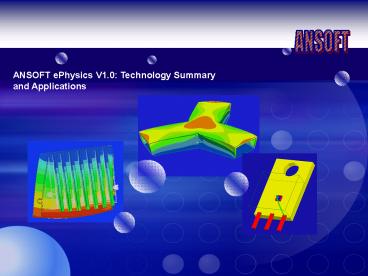ANSOFT ePhysics V1'0: Technology Overview and Applications - PowerPoint PPT Presentation
1 / 32
Title:
ANSOFT ePhysics V1'0: Technology Overview and Applications
Description:
EM low frequency. Electrostatic. Magnetostatic. Electric ... Transient EM Rigid Body Motion. Transient Thermal. Electrostatic. Elastostatic. Static Thermal ... – PowerPoint PPT presentation
Number of Views:365
Avg rating:3.0/5.0
Title: ANSOFT ePhysics V1'0: Technology Overview and Applications
1
ANSOFT ePhysics V1.0 Technology Overview and
Applications
2
Presentation Summary
About ePhysics Features in ePhysics V1.0 Markets
Applications Conclusions
3
ePhysics for Electromagnetic Applications
HFSS EM high frequency
ePhysics - Thermal - Stress - CFD - .
Maxwell EM low frequency
Electrostatic
Electric
Magnetostatic
4
Higher Level Analysis
Geometry
CAD Level
Maxwell (low frequency)
HFSS (high frequency)
Electro-magnetics Level
ePhysics Thermal/Stress
Multi-physics Level
Optimetrics Parametrics/Optimization/Sensitivity
Analysis
5
ePhysics TM Functional Links
6
Presentation Summary
About ePhysics Features in ePhysics V1.0 Markets
Applications Conclusions
7
3D Thermal Transient
initial condition
8
Solution Process HFSS - Thermal
Initial (coarse) thermal mesh
Controls both accuracy of thermal solution AND
accuracy of power loss mapping
Maxwell/HFSS
Thermal
9
Heat Transfer Mechanisms
Convection
Radiation
Conduction
Natural
Forced
10
Frequently Used ThermalSources
On solids
On surfaces, surface can be between objects
11
Frequently Used Thermal Boundary Conditions
Can be functional! (temperature dependent) Can
include radiation if needed! Models CFD effects
12
Structural analysis(basic quantities,
relationships)
Volume force density
Strain tensor
Equilibrium condition
Boundary condition
External traction
Stress tensor
Constitutive relations
E Youngs modulus ? Poissons ratio a
coeff. of thermal expansion G shear
modulus
13
Structural Boundary Conditions
Homogeneous displacement (On any surface of a
group of connected bodies)
Rigid body equilibrium is guaranteed
Rigid body equilibrium is not guaranteed,
user can choose an anchored boundary condition)
Tangential displacement (usually needs a local
coordinate system to be defined)
Rigid body equilibrium is not guaranteed,
user can choose an anchored boundary condition)
Normal displacement (a local coordinate system is
not necessary)
Note rigid body motion must be eliminated to
avoid singular structural problem
14
Presentation Summary
About ePhysics Features in ePhysics
V1.0 Applications Conclusions
15
Schottky Diode Structure
10 mm
leadframe
case
chip
wire
16 mm
16
Thermal Sources and Boundary Conditions
28.8 W (50) active area
28.8 W (50)
Dirichlet Boundary Condition 25 oC
17
Results
Mesh detail
Steady state temperature distribution
18
IC structure in HF incident field
Top plane heated by incident wave
Metal ground planes vias imbedded in ceramic
block
Temperature distribution on ceramic block after
200 s
Temperature distribution on cross section
19
IGBT Application(geometry)
Molding
Current path
Copper piece
Solder layers
Dielectric
Aluminum back plane
Heatsink
20
IGBT Application(results)
Mesh detail
Heat flow vector distribution
Temperature distribution
21
Solenoid thermal modelfor injector
Convective BC on all exterior surfaces
Housing
Coil
Armature
Resin
Needle
Seat
22
CPGA Packaging
Intel Ceramic Pin Grid Array Package
23
Typical PCB
Layer 1 (FR4)
Layer 2 (FR4)
Layer i (FR4)
Copper
Layer N (FR4)
- 4 layers FR4 with 0.25 W/m K
- 2 internal layers of copper with 390 W/m K
- 35 mm thick copper layers (1oz/ft2)
Maxwell thermal conductivity tensor
24
ePhysics Thermal Model (CPGA)
Ceramic top
Ceramic frame
Die
Metallic cap
Pins
Socket
Socket pins
Pcb
25
ePhysics Results CPGA
Temperature profile
Heat flow
26
ePhysics Thermal Model (SBGA)
Cu heat spreader
Die attach
Adhesive
Copper ring
Mold compound
Die
Multilayer
BGA
27
ePhysics Results for SBGA Model
lt10 heat flow
0.66 W
2W
gt90 heat flow
1.14 W
28
PCB Level Analysis
Forced convection BCs on the PCB top and bottom
surfaces
3 W
Air flow 5 m/s
230 mm
6 W
230 mm
29
PCB Level Analysis(results)
Temperature distribution in a cross section
30
High Power Handling HF filters
31
Presentation Summary
About ePhysics Features in ePhysics
V1.0 Applications Conclusions
32
Conclusions-Main ePhysics V 1.0 features-
- Electromagnetic power loss density distribution
mapped automatically to thermal problem mesh - All major heat transfer mechanisms implemented
(conduction, convection, radiation) - Non-linear steady state and transient thermal
solvers - Thermal (steady state transient) coupling to
stress - Functional (temperature dependent) thermal
boundary conditions

